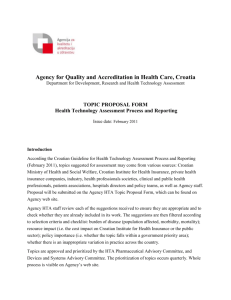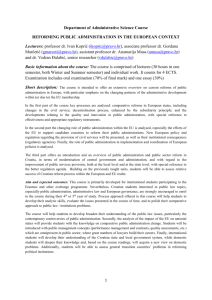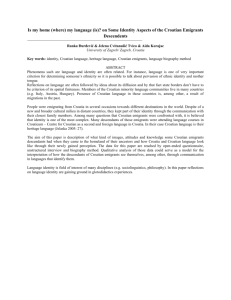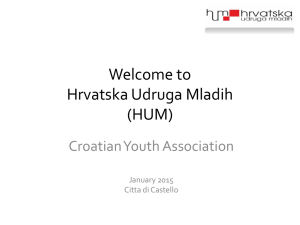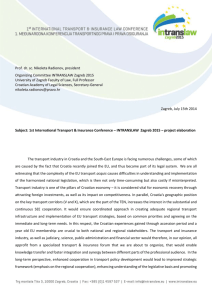The Use of Comparative Legal Analysis in Teaching the Language
advertisement
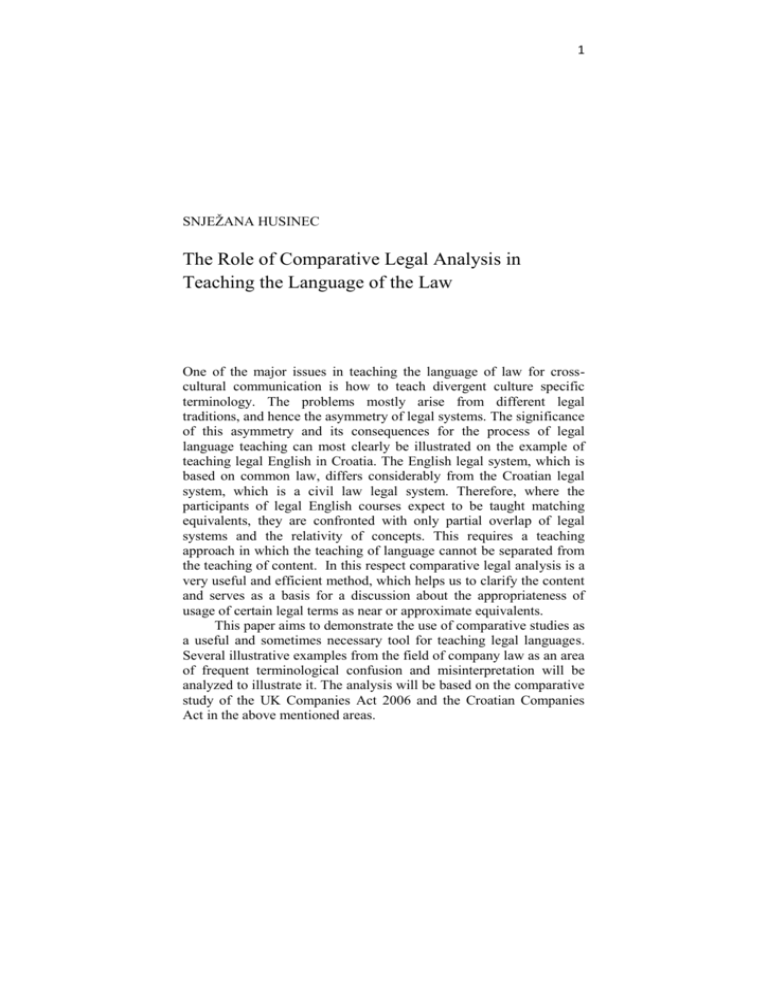
1 SNJEŽANA HUSINEC The Role of Comparative Legal Analysis in Teaching the Language of the Law One of the major issues in teaching the language of law for crosscultural communication is how to teach divergent culture specific terminology. The problems mostly arise from different legal traditions, and hence the asymmetry of legal systems. The significance of this asymmetry and its consequences for the process of legal language teaching can most clearly be illustrated on the example of teaching legal English in Croatia. The English legal system, which is based on common law, differs considerably from the Croatian legal system, which is a civil law legal system. Therefore, where the participants of legal English courses expect to be taught matching equivalents, they are confronted with only partial overlap of legal systems and the relativity of concepts. This requires a teaching approach in which the teaching of language cannot be separated from the teaching of content. In this respect comparative legal analysis is a very useful and efficient method, which helps us to clarify the content and serves as a basis for a discussion about the appropriateness of usage of certain legal terms as near or approximate equivalents. This paper aims to demonstrate the use of comparative studies as a useful and sometimes necessary tool for teaching legal languages. Several illustrative examples from the field of company law as an area of frequent terminological confusion and misinterpretation will be analyzed to illustrate it. The analysis will be based on the comparative study of the UK Companies Act 2006 and the Croatian Companies Act in the above mentioned areas. 2 1. Introduction - Legal language as a language for specific purposes The language of law as a language for specific purposes has been developed by experts primarily for the purpose of professional communication. As such it uses technical terms and phrases and shows a number of structural peculiarities (some grammatical and syntactical special features like lengthy and complex sentences, nominal style, passive voice etc.). Therefore, it differs considerably from ordinary speech and writing. However, legal language differs also from other languages for special purposes in that it is entirely created by humans and therefore closely linked to the culture of a particular society (Mattila, 2006: 105). Legal languages are shaped by the legal system in which they are used. Since different legal systems have different legal rules, legal concepts differ as well. For this reason the semantic domains of legal terms do not correspond with one another (Mattila, 2006:105). To what extend this disparity goes depends on the historical interaction between two legal cultures concerned. For instance, the Croatian legal concepts do not differ as much from German legal concepts as they do from the English ones. Such intercultural differences between various legal systems are of central importance to legal language and cause frequent misunderstandings in international legal communication. At the same time they make legal language special and legal language teaching different from teaching most other languages for specific purposes. 3 2. Teaching the language of law for cross-cultural communication The citizens’ increased mobility and the globalization of trade and international economic relationships, involving the need to do business in a foreign legal system and a foreign language have intensified international communication in the area of law. Croatia is not an exception here. In recent years many foreign, international companies have entered the Croatian market, many foreign investors have established companies in Croatia. Additionally, in Croatia as an EU acceding country a number of lawyers are involved in the process of harmonization of Croatian law with EU law, where their knowledge of foreign legal languages is indispensible. In such circumstances legal language courses are gaining in popularity. First of all legal practitioners (judges, practising lawyers, company counsels, legal trainees etc.), sometimes pushed a little by their employers and the institutions they work for are becoming aware of the importance of good command of a foreign legal language for efficient international communication and show a growing interest for attending legal language courses. The main objective of such courses it to develop professional language skills of the participants and in this way appropriately equip them for successful and accurate communication in their international legal contacts. This means in the first place that the participants need to master foreign legal concepts and terminology and learn about the similarities and differences between the foreign and their national law in order to be able to relate their legal system to the one of their clients or colleagues and discuss different issues of a foreign and their own legal system in a foreign language, as well as provide advice regarding their national law in a particular foreign language. In other words they 4 have to acquire the knowledge of a foreign legal language and be able to apply it to the national legal concepts. Therefore, when teaching legal language for cross-cultural communication the legal language teacher is confronted with an extremely difficult task. The teacher needs to teach a highly specific language which tends to have lengthy and complex sentences, sometimes outdated grammar and archaic and highly formal words and expressions. However, one of the most difficult tasks in the instruction and acquisition of legal language is system-bound, deeply culturally embedded legal terminology, which is tied to the legal system rather than to the language (Pommer 2008: 18) and is most of all affected by cultural diversity. On the other hand the expectations of course participants don’t make the process of teaching any easier. They mostly expect readymade one-to-one linguistic equivalents where, because of different legal traditions underlying various legal languages, there is sometimes neither linguistic nor legal equivalence. The participants tend to translate foreign law into their own law and are not aware of the cultural diversity and its consequences for legal language. For this reason, a teacher of a foreign legal language has to deal at the same time with the relevant grammatical and syntactical difficulties as well as terminological conventions, but also has to raise the student’s awareness of the cultural differences between the legal systems concerned and potential dangers of misinterpretation arising from them. 3. Content-based approach to teaching legal language The question is, what is the most effective way to teach a language that is so dependent on the content. How should one effectively teach legal concepts and terms that are specific for a particular legal system and differ from other systems? How to avoid conceptual 5 misunderstandings and terminological confusions that only to a lesser extend arise from asymmetric languages and primarily are the consequence of the structural differences between legal systems (De Groot in Galdia, 2003:2)? It calls for a model of teaching in which language cannot be separated from the content. In order for the participants of legal language courses to understand foreign legal concepts and exact meanings of legal terms it is essential that they learn them through the content and in their original form/legal context. In other words they need to learn legal language by learning about foreign law. In such circumstances the best teaching method is content-based instructionCBI, an approach to foreign language teaching which postulates “the integration of content learning with language teaching aims” (Brinton at al., 1989: 2). It is based on the premise that language must be used as a medium for learning content, and content as a resource for learning language. CBI refers to the concurrent study of language and subject matter and supports contextualized learning. In a legal language course language acquisition remains the primary goal, however, specialist content is used as a medium for learning legal language, since for successful language acquisition it is necessary that the “input” in the target language is understood by the learner (Krashen in Brinton at al., 1989: 3). Naturally, the more divergent the legal systems underlying particular legal languages are, the more knowledge of content is needed to convey the meanings of terms and phrases. However, in order to avoid ambiguities and to enable the participants to accurately communicate information about their own and foreign law it is not sufficient to study the language simply on the content concerning particular area of foreign law, but it is necessary to compare and contrast it with one’s own legal system, that is, to compare how a particular area of law is regulated in the jurisdictions at issue, how legal terms are defined and what are their functions. It is necessary to analyse and contrast different legal systems, their 6 structural characteristics, concepts and terms. A knowledge of the similarities and differences between legal concepts of various countries, namely, helps avoid misunderstandings in international cooperation (David & Brierley in Mattila 106). To achieve this goal content-based teaching has to be supplemented by the comparative study of different legal systems in the particular areas taught in a legal language class. 4. Comparative legal analysis – an efficient tool for overcoming the cultural gap Comparative study of the laws and legal systems of different jurisdictions in terms of their similarities and differences is undergoing rapid growth in an age of rising globalisation and is widely used for different purposes. It can very well be exploited in the legal language classroom as well. The comparative analysis of particular areas of law can be a very useful and efficient tool for teaching legal languages for international communication. It facilitates teaching and learning by helping the participants overcome the cultural gap between their own legal language and a foreign one. Both, the course participants and the language teacher, who usually lacks any kind of formal legal training, can profit from comparing and contrasting legal concepts, terms and areas of law in two legal traditions. Small comparative studies conducted in the classroom help us understand dissimilarities between legal systems, clarify the content of legal terms, recognize the closest functional equivalents and, finally, they help the teacher raise the students’ awareness of intercultural differences between legal systems and their consequences for the language. 7 4.1 Comparative legal analysis: Methods For the purpose of undertaking comparative legal analysis two methods have proved themselves very useful in the legal language classroom. 4.1.1 Juxtaposition of features of an area of law in two jurisdictions The method of juxtaposition of features of some area of law in two jurisdictions is used for the purpose of discovering possible inconsistent categorizations and terminological incongruity. It contrasts all relevant features of the particular aspect of law of one legal system with another by juxtaposing them in order for the participants to become aware and learn about the dissimilarities between legal system and potential dangers of misinterpretation they might cause. In this way the foundation for further language work in the particular area of law is laid. 4.1.2 Componential analysis of meaning of legal terms In order to discover what is the conceptual information transmitted by certain terms, that is, to clarify the content of the terms and make it possible to recognize functional equivalents, componential analysis of meanings of legal terms can be conducted. So, by simply breaking down words into smaller parts (distinctive features or components of meaning) different features of terms are contrasted and the degree of similarity and equivalence is determined. The method is based on Nida’s theory that “a meaning is not a thing in itself, but only a set of contrastive features” (Nida, 1975:51). Such analysis reveals to what extend there is a semantic overlap between legal terms used in different legal traditions and helps avoid confusions in legal communication in a foreign language. For this purpose the usual 8 procedure of denoting the existence of a certain feature with a plus (+) and the lack of it with a minus (–) is applied. 4.2 Comparative legal analysis: Resources The resources for conducting comparative analysis in the legal language classroom can be of different kinds. Wherever possible, it is recommendable to use legislative texts as the most trustworthy source of legal information. By analysing codes and their definitions of legal terms and regulations of a particular areas we get the most accurate and reliable information about foreign and national law. Of course, other reliable sources such as good monolingual legal dictionaries (eg. Black's law dictionary), legal textbooks and legal encyclopaedias, some reliable web pages dealing with law, as well as all other comparative law resources can be valuable sources of information. 5. The use of comparative legal analysis in teaching legal English in Croatia The significance of different legal traditions underlying legal languages and their impact on the process of legal language instruction can most clearly be illustrated on the example of teaching legal English in Croatia. The English legal system as a common law legal system differs considerably from Croatian law, which is a part of the Middle European continental law and is largely modelled on German law. Therefore, the participants of legal English classes are confronted with only a partial overlap of legal systems, different classifications, 9 divergent legal concepts and consequently a lack of linguistic and legal equivalence. In order to be able to fully understand the content of legal terms, to avoid misinterpretations and use the terminology properly as well as to develop the awareness for cultural differences it is essential for the participants to learn about English law and to contrast it with Croatian law. Owing to considerable differences between continental and common law and the fact that business entities are defined in national legislations, company law is an area with significant terminological problems. Therefore, the use of comparative analysis in teaching legal languages can best be illustrated by using the examples from the UK and Croatian company law. 5.1 Example I: Company law in the UK and Croatia - Fundamental regulations The first step in the comparison of an area of law in two jurisdictions should be the identification of legislative acts governing the area as the basic sources of reliable information. They are necessary for further more detailed analysis and help the participants discover the first similarities and differences in the structure of the particular area of law. UK CROATIA INCORPORATED ENTITIES ALL BUSINESS ENTITIES 1)UK Companies Act 2006 OTHER BUSINESS ENTITIES 2) Limited liability Partnership Act 3) Partnership Act 4) Limited Partnership Act 1) Croatian Companies Act 1993 (last amended in 2007) 2) Croatian Court Registry Act 10 Table 1: Company law - UK vs. Croatia – Juxtaposition of principal legislative acts Company law in the UK is a part of common law legal system and primarily governed by the UK Companies Act 2006 as the most extensive and most important act in the field of company law regulating incorporated forms of business organization. There are three more acts referring to other types of business entities. On the other hand, company law in Croatia is governed mainly by the Croatian Companies Act (Zakon o trgovačkim društvima), a statute largely modelled on German legislation. The act regulates different types of business forms, the incorporated ones as well as the unincorporated ones. So, already at the beginning of our comparative study we stumble across a divergence. The term “company” appears here as a confusing one, since, owing to the official English translation of the Croatian Zakon o trgovačkim društvima (Croatian companies act) we associate it with the British “Companies Act”. The translation leaves the impression that the two acts are equivalent although in reality they do not regulate the same legal area. Namely, the incorporated business entities as well as partnerships are referred to as “trgovačko društvo” (trading company) in Croatia and are regulated by the same act, whereas the term “company” in its original meaning, as used under English company law, denotes exclusively “incorporated entities”. So, the analysis reveals basic dissimilarities in the structure of company law of two jurisdictions and clarifies the meaning of the crucial term in the area of company law which can easily cause some confusion in real life communication. 5.2 Example II: Principal types of business entities To be able to teach the terminology of company law and to discuss the area with the course participants it is necessary to identify and contrast 11 the principal forms of business organization in the two jurisdictions. Since types of business entities vary across jurisdictions the concepts are bound to differ and it is sometimes impossible to translate the terms into another language. UK I sole traders II partnerships (or general partnerships) III limited partnerships CROATIA I trgovac pojedinac (sole trader) II companies of persons - javno trgovačko društvo (general partnership) -komanditno društvo (limited partnership) IV limited liability partnerships V limited companies - private limited companies LTD. - public limited companies p.l.c. VI unlimited companies III companies of capital -dioničko društvo - d.d. (limited liability company) - društvo s ograničenom odgovornošću – d.o.o. (joint stock company) Table 2: Principal types of business entities - UK vs. Croatia As the above table shows, the UK Companies Act 2006 classifies business organizations differently from the Croatian Companies Act. UK law distinguishes between six principal business forms - two of them being incorporated (i.e. business with a separate legal identity from that of their owners) and four unincorporated (i.e. with no legal difference between the owners and the company), while the Croatian Companies Act recognizes three principal types of business forms, which are then further subdivided. It is clear that due to different classification there is almost no linguistic equivalence between Croatian and UK business entities. This fact alone calls for caution when using foreign terms and trying to apply them on the Croatian company law. In order to discover to 12 what extend particular business entities are similar or different and possibly identify near or functional equivalents a more detailed study of their characteristics must be carried out. The characteristics of the business forms in question have to be contrasted, that is, their semantic components have to be compared. Therefore, the next step in the comparative study of the field is the componential analysis of semantic features of particular business entities in the two legal systems based on the regulations from the UK Companies Act and the Croatian Companies Act as primary legislative texts in the field of company law. 5.3 Example 3: Public limited company vs. dioničko društvo Let’s illustrate the procedure by taking the Croatian dioničko društvo or d.d. and a public limited company, both being types of a joint stock company, and compare their features by means of componential analysis in order to see if they fulfil the same function and are thus comparable.1 Publicly traded shares Minimum capital requirement No personal liability/ liability limited to shareholder contributions Managed by the board of 1 UK – Public limited company p.l.c. + + CROATIA – Dioničko društvo d.d. + + + £ 50 000 + 200 000 kuna (~ £ 25 000) + +/- As Pommer points out “Functionality is the basic principle of comparative law claiming that legal concepts are comparable only when they fulfil the same function .” (Pommer 2007-1 in Pommer 2008, 19) 13 directors Can be a single member + company Table 3: Componential analysis of public limited company and dioničko društvo based on the UK Companies Act and the Croatian Companies Act As the componential analysis reveals, both public limited company in the UK and dioničko društvo are owned by shareholders and are able to make shares available to the public. Neither of them, however, is necessarily a publicly quoted company (although p.l.c. bears the adjective public in its name). Further similarities are that d.d. as well as p.l.c. must have a minimum share capital in order to be registered and that their shareholders are limitedly liable depending on their contributions. Both companies are managed by professional management, the UK public limited company by the board of directors, whereas the Croatian dioničko društvo can either have a two-tier board (consisting of the management board and the supervisory board) or a one-tier board (management board) (see 5.6). However, unlike the Croatian dioničko društvo the UK public limited company still cannot be owned by a single member/shareholder. On the basis of the comparative analysis of the basic features of the two companies we can conclude that although ‘public limited company’ and ‘dioničko društvo’ are not linguistic equivalents and not 100 % legal equivalents the two companies are very similar forms of business organization which do not considerably differ in their characteristics and in the functions they fulfil, and can thus be used by Croatian lawyers as functional equivalents. 5.4 Example IV: Documents required for company formation The same type of comparative analysis is beneficial when for one term there are two possible terms in another jurisdiction. This is the case with the documents needed for company registration in the UK and Croatia, the area which causes most confusion and misinterpretation and is of extraordinary importance for Croatian lawyers when 14 advising their international clients concerning setting up a company in Croatia. Bilingual dictionaries are not helpful here, since they provide a range of terms which do not help the understanding of differences in the system, but only create an additional mess. Main document for registration of the company States that the subscribers wish to form a company Sets out the company's name, registered office, address, the objects of the company States the authorised capital Prescribes regulations for the company Defines the intermanagement, inter-member and inter-employee relationship Društveni ugovor Memorandum of association Articles of association + + - + + - + + - + + + - + + + - + Table 4: Comparative analysis of Croatian and UK documents needed for company registration According to the UK company law two documents are needed for registration with the Companies House (constitutional documents), whereas in Croatia there is one constitutional document which needs to be submitted to the Court Register. Only by contrasting the semantic components of the three documents extracted from the regulations of the two companies acts, in other words, by contrasting the information that they must contain, we can decide what they have in common and to what extend the Croatian ‘društveni ugovor’ overlaps functionally with the two UK documents. As shown in table 4, ‘društveni ugovor’ (Croatia) and the memorandum of association (UK) state that the subscribers wish to form a company and agree to become members, they set out the company’s name, the registered office and address as well as the 15 objects of the company. The authorised capital is stated in all three documents, whereas only ‘društveni ugovor’ and the articles of association prescribe the regulations for the company and define the relations between the members, the members and the management and the employees. The analysis shows (see table 4) that the semantic domain and function of ‘društveni ugovor’ is broader and that it encompasses the functions of both UK documents. Therefore, we can claim that the equivalence is only approximate. For the purpose of translation memorandum of association (being the main document for registration) could be taken as a closer equivalent, but for the Croatian lawyers it is important to be aware of the fact that the documents contain different information, i.e. their meanings and functions correspond only partially due to cultural asymmetry. For this reason lawyers working for law firms which are typically engaged to organize and conduct the company registration procedure must be extremely cautious to avoid confusion arising from a number of English and American terms used by experts and lay people in Croatia for documents for company formation. It should be noted here that the same technique can very effectively be applied to clearing away the confusion between different British and American terms in relation to Croatian terminology, since differences between the UK and US company law terminology may account for further ambiguities. 5.5 Changing of capital structure – “Merger” MERGER the undertaking, property and liabilities of one or more public companies, are to be transferred to another existing public company the undertaking, property and liabilities of two or PRIPAJANJE SPAJANJE + ( ‘merger by absorption’) + + (‘merger by - 16 more public companies are to be transferred to a new company formation of a new company’) - + Table 5: Componential analysis of meaning of the terms denoting changing of capital structure In the area of fundamental changes of a company terminological confusion is partly influenced by parallel usage of legal and popular (widely used) terms. For merger, for instance, we come across nine different terms in the English-Croatian dictionary (fuzija, integracija, preuzimanje, sjedinjenje, pripajanje, spajanje, udruživanje, konsolidacija, komasacija). How do we know what the term ‘merger’ actually stands for in UK law and what is its Croatian legal equivalent? All the ambiguities disappear once we have consulted the two companies acts. According to what can be extracted from the definition of ‘merger’ found in the UK Companies Act, it refers to two different ways in which company structure can be changed : (a) the undertaking, property and liabilities of one or more public companies, are to be transferred to another existing public company (a ‘merger by absorption’), which is in Croatia referred to as ‘pripajanje’ (i.e. a change in capital structure, where the acquired company ceases to exist, and is absorbed into the acquiring company), or (b) the undertaking, property and liabilities of two or more public companies, are to be transferred to a new company, whether or not a public company, (a ‘merger by formation of a new company’); the concept covered in Croatian company law by the term ‘spajanje’ (i.e. when both companies disappear and a new company is formed). So, obviously, each type of structural change denoted by ‘merger’ is covered by a different term in the Croatian Companies Act. The analysis discloses lexical asymmetry, that is, that one English term is covered by two Croatian terms. Furthermore, it shows 17 which of the dictionary terms are legal terms and appropriate translations of ‘merger’. Such comparative study clarifies the terms and their functions and clears away the ambiguity. 5.6 Example 6: Company management – Public limited company vs. dioničko društvo The terminological dilemmas concerning the management of publicly traded companies in the UK and Croatia can also be resolved by means of comparative analysis. The questions regularly asked by participants of legal English courses when discussing the management of UK companies are: „Is the ‘board of directors' the same as our ‘uprava’ (management) „How would they call our ‘nadzorni odbor’ (supervisory board) and who plays the role of supervisory board in the UK companies?“ In order to answer the questions, it is necessary to confront the participants with the cultural differences between the UK and Croatian company law regarding company management. PUBLIC LIMITED COMPANY (p.l.c.) ONE-TIER BORD The board of directors = executive and non-executive directors (2 or more members) =appointed by controlling shareholders =elected at AGMs, answer to AGM = manage the company and decide its general policy DIONIČKO DRUŠTVO (d.d.) A) TWO-TIER BOARD The management (uprava) = one or more members, appointed by and answer to the supervisory board The supervisory board (nadzorni odbor) = outside experts and representatives of employees = appointed at & answer to AGM B) ONE-TIER BOARD (since 1 April 2008 in effect) The management board (upravni odbor) = executives and non-executives (+representatives of employees if prescribed by the law) =elected at & answer to AGM =manage the company and decide 18 general policy Table 6: Company management of p.l.c. and d.d. By contrasting the management organs of the Croatian d.d. and the UK p.l.c., their structure and duties, the reasons for the confusion become obvious. In Anglo-Saxon countries there is a one-tier board in which all directors, executive as well as non-executive are represented. They are all appointed by shareholders and elected at annual shareholder meetings. Their main duty is to manage the company and decide the company’s general policy. Under Croatian law, on the other hand, until 1st April 2008, when the amendments to the Companies Act 1993 came into effect, only the dual structure of administration for ‘dioničko društvo’ was possible. Therefore, the executive and supervisory responsibilities in Croatian companies were separated. In the so called two-tier board (typical for the Germanic countries) these responsibilities were divided between the management board (uprava), sometimes also referred to as executive board, which manages the company and answers to the supervisory board, and the supervisory board (nadzorni odbor), which represents the shareholders interests. Pursuant to the amendments to the Croatian Companies Act there is an alternative to the two-tier board for Croatian companies. Namely, under the influence of Anglo-Saxon legal systems since 1st April 2008, Croatian ‘dioničko društvo’ can decide to have only the ‘board of directors’ (whose structure and duties almost equal the UK board of directors) instead of both the ‘management board’ (uprava in the old two-tier system) and the ‘supervisory board’ (nadzorni odbor). The comparative study brings us to the conclusion that the terminological ambiguities concerning the highest governing bodies in companies are due to different legal traditions. Additionally, it shows a tendency toward the international harmonization of company law in civil and common law jurisdiction. It seems that Croatian law as a civil law legal system, has started adopting some elements of the Anglo-Saxon common law system, which evidently prevails in international business. 19 6. Classroom activities based on comparative legal analysis There is a variety of classroom activities which can be based on comparative legal analysis and at the same time practice the four language skills. Let me describe a few very effective ones for the mentioned purposes which proved very successful in the classroom. 1.What’s the difference In the first activity the focus is on comparing two terms from the legal systems at issue. The students are supposed to find definitions of two given terms and in a componential analysis compare their content by extracting the components of their meaning from the found definitions. The teacher directs the students to particular sources of information (legislative texts, monolingual dictionaries, reliable Internet sites or law lexica). The students create a table, extract relevant features from definitions, fill in the table and present it to the class. 2.Expert chat The second activity is a communicative activity in which pairs of students are given tables with features of different areas of law already filled in. Student A gets only the part of table containing the information on one legal system and student B gets the other part of the table. By asking questions about the other system and answering questions about their own legal system on basis of the table the students collect the relevant information and complete the table. After the tables have been completed a class discussion follows. 3.Researching different legal systems The third activity is a research task in which the students use the Internet to discover information about particular areas of law in their national and foreign law. By juxtaposing the relevant information in two parallel columns they contrast the two legal system and present 20 their findings to the class. As a follow up activity the students write a report for a senior partner (in legal English) or an email to a client in which they present the newly acquired information (in plain English). The teacher prepares reliable Internet sites for the students to use. 4.Student presentations In short 10 to 15 minute individual presentations on an aspect of law in their national and foreign legal system the students practice their presentation skills in a foreign language along with the comparative study of a legal topic. After having researched about some area of law (by using the resources previously discussed with the teacher) the students prepare a contrastive analysis and present it in class. All the above activities have a double purpose. On the one hand they can be well used to compare and clarify the differences between legal systems, concepts and terms and at the same time they lend themselves to the integrated teaching of the four traditional language skills. 7. Conclusion To sum up, a course in legal language is primarily a language course and not a course in foreign law and its main objective has to be to teach legal practitioners or future lawyers professional language skills and legal terminology needed for cross-cultural communication in the area of law. However, due to cultural differences between legal systems and their linguistic implications, it is necessary to adopt a content-based approach to teaching of the language of the law in which comparative legal analysis is used as a useful method to overcome the gap between legal cultures. The primary function of comparative legal analysis in teaching legal language is firstly, to clear away possible conceptual and terminological misunderstandings 21 and confusions arising from the asymmetry of legal systems by clarifying the content of legal terms and to establish functional equivalents, and secondly, to contrast whole areas of different legal systems in order to discover dissimilarities in the structure of the area and their consequences on the language. Only in this way the participants of legal language courses will be adequately prepared for accurate transmission of legal information in their international contacts. 8. References i) books: Barbić, Jakša 2007. Zakon o trgovačkim društvima. Zagreb: Organizator. Brinton, Donna M. / Snow, Marguerite Ann / Wesche, Marjorie Bingham 1989. Content-Based Second Language Instruction. New York: Newbury Dignam, Alan / Lowry, John 2009. Company Law. New York: Oxford University Press. Hutchinson, Tom / Waters, Alan 2005. English for Specific Purposes. Cambridge: Cambridge University Press. Krois-Lindner Amy & Translegal. 2006 International Legal English. Cambridge: Cambridge University Press Matilla, Heikki E. S. 2006. Comparative Legal Linguistics. Aldershot: Ashgate Publishing Limited. Nida, E.A. 1975. Componential analysis of meaning – An Introduction to Semantic Structures. The Hague, Mouton Publishers Pommer, Sieglinde 2006. Rechtsübersetzung und Rechtsvergleich. Frankfurt : Peter Lang Verlag. 22 ii) articles in journals: Galdia, Marcus 2003. Comparative law and legal translation. In The European Legal Forum (E) 1-2003, 1-4 at <http://:www.european-legal-forum.com˃. Pommer, Sieglinde 2008. Translation as Intercultural Transfer: The Case of Law. In SKASE Journal of Translation and Interpretation [online]. 2008, vol. 3, no. 1 [cit. 2008-04-21]. <http://www.skase.sk/Volumes/JTI03/pdf_doc/2.pdf>. ISSN 1336-7811˃. iii) internet addresses: The UK Companies Act 2006 at <http://www.opsi.gov.uk/ acts/ acts 2006/ukpga_20060046_ en _1˃. Zakon o trgovačkim društvima, NN 111/93 at < http://narodnenovine.nn.hr/clanci/sluzbeni/260024.html˃. Zakon o izmjenama i dopunama zakona o trgovačkim društvima at <http://narodne-novine.nn.hr/clanci/sluzbeni/329385.html˃.
